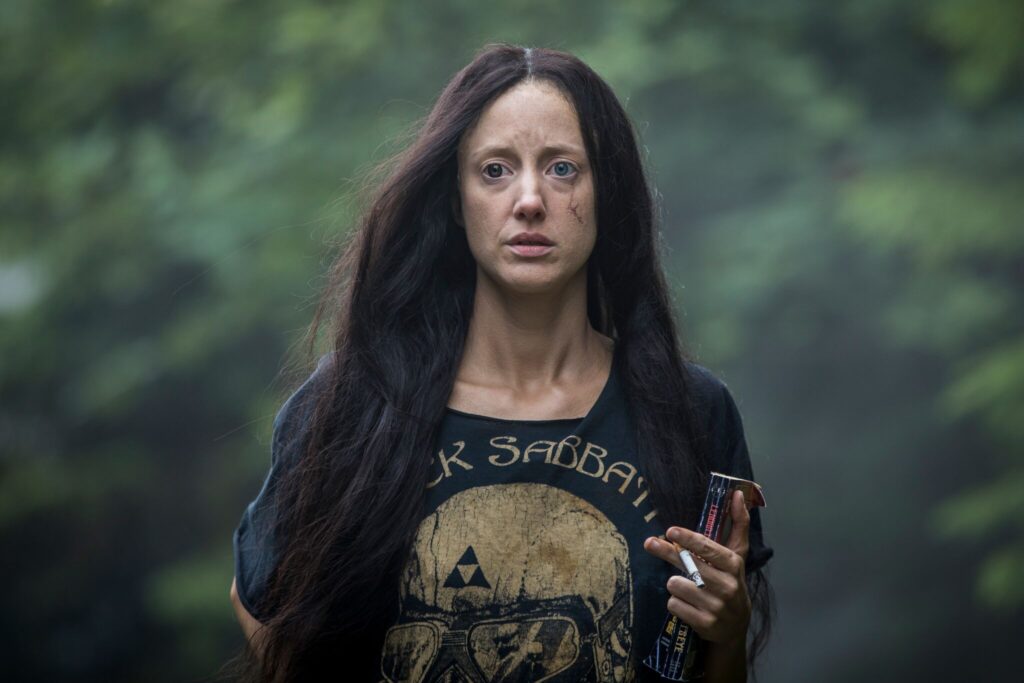Possessing a much more coherent narrative than Panos Cosmatos’ visually inventive 2010 film “Beyond the Black Rainbow,” “Mandy” is none-the-less a bizarre revenge yarn that begs to be watched, at least, twice. Maybe three times…
 C
C hanneling the 1980s, director Panos Cosmatos sets his latest film in 1983, amid the feral wilderness. In a spacious A-frame type mountain cabin, Red Miller (Nicolas Cage) lives a peaceful life with his girl Mandy (Andrea Riseborough). She’s an unusually alluring femme fatale with a prominent scar on her face that even makes her more interesting—a seductive mystery woman. And to further endear her to the opposite sex, Mandy ravenously reads fantasy fiction and dons black, heavy metal t-shirts. She’s the perfect partner for the rough and tumble Red, who spends his days in the towering forest performing all manner of manly lumberjack duties. The two share an intimate bond, barely needing words to communicate their love for one another.
hanneling the 1980s, director Panos Cosmatos sets his latest film in 1983, amid the feral wilderness. In a spacious A-frame type mountain cabin, Red Miller (Nicolas Cage) lives a peaceful life with his girl Mandy (Andrea Riseborough). She’s an unusually alluring femme fatale with a prominent scar on her face that even makes her more interesting—a seductive mystery woman. And to further endear her to the opposite sex, Mandy ravenously reads fantasy fiction and dons black, heavy metal t-shirts. She’s the perfect partner for the rough and tumble Red, who spends his days in the towering forest performing all manner of manly lumberjack duties. The two share an intimate bond, barely needing words to communicate their love for one another.

One day, while Mandy is taking a relaxing midnight stroll, she’s noticed by an ugly cult leader named Sand Jeremiah (Linus Roache), who is immediately intrigued by her. He commands his second in charge to fetch her for him. And to accomplish this task, the cult employs leather clad motorcycle freaks that would be right at home in a “Road Warrior” installment. Of course, Mandy rejects the invitation extended by Sand, who decides that if he can’t have her, no one will.
When Sand executes a terrible sentence upon Mandy, he leaves Red tied down and made to watch his true love’s horrific demise. Leaving Red alive was a terrible mistake. And remember Red is played by Nicolas Cage in full lunatic mode.

I’ve only seen “Mandy” one time, but unlike Cosmatos’ last film “Beyond the Black Rainbow,” I think it’s worth revisiting. It’s not that I did not appreciate “Rainbow,” it’s just that I had a hard time connecting with the story. Ultimately, I was unable to make much sense of it, even though it looked really cool. By contrast, “Mandy” is a less complicated movie, at least, on the surface. Without question, it’s a very direct and bloody violent revenge journey, but there’s something deeply subversive at work underneath it all.
Consistent with “Rainbow,” Cosmatos emphasizes visuals over most anything else. But here those visuals gel perfectly with the familiar, universal vengeance theme. Along with director of photography Benjamin Loeb, he crafts an ominous look that really sets a brutal tone. While the Arri Alexa camera was used with anamorphic lenses, the high-contrast, dark look of “Mandy” is very reminiscent of something produced by the Red camera. It’s a retro, crunchy filmic production—a fantastic hybrid of 1970s grind house and high gloss Spielberg lens flare 1980s. Loeb and Cosmatos deliver a distinctive collection of images that convey the setting authentically. These images envelop you, making you feel itchy as the narrative progresses.

And when those crushed and oppressive visuals combine with an equally crushing unhinged Cage performance, you have a near perfect concoction—a Cage-tastic combustion. It goes without saying that Nicolas Cage is an actor capable of freakishness without the assistance of special effects. He’s got something dark and delicious in him that bursts forth upon command. It’s a demon of some sort that enchants us more than an endless loop of Tom Cruise running. And no matter how many times we experience that demon rampage, we are enthralled. Cosmatos knows that the way to best use Cage is to free the demon and let it devour everything on screen. And when the Cage is opened, “Mandy” becomes undeniable, huge entertainment.

But Riseborough’s work here, especially when she interacts with Roache is very interesting. Roache plays Sand like a 1970s Jim Jones relic, an aging cult leader, who may be suffering from erectile dysfunction. It’s clear that Sand never garnered a big enough following to build his own compound in Guyana, and he’s a coward at his core. And Riseborough, who has very few lines, knows how her Mandy should reject Sand’s insecure, feeble advances reducing the vaunted fake Massiah in the most embarrassing way possible. And still, the controlled rage that Sand draws upon is nothing compared to what he inadvertently calls forth from Red, who has skilled talent with a huge chainsaw and a particularly lethal homemade ax.
“Mandy” is a violent bloodbath of a film. It’s more thrilling than actually frightening. And lurking in the subtext, there’s a deeply subversive fable waiting to be unlocked, but that will come to me when I see the film again.
